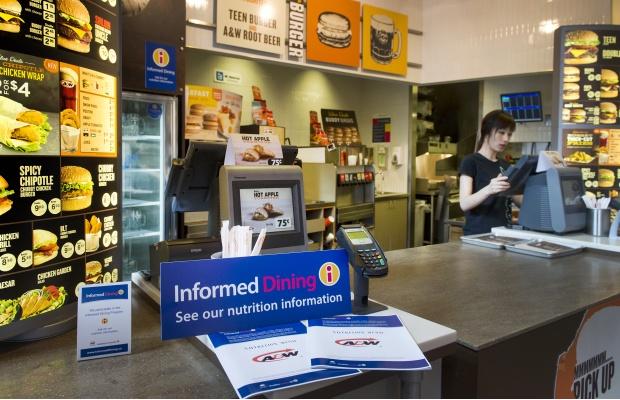TORONTO – Canadians in several provinces may soon be able to get information on how much fat, sodium or sugar is in the food they order at various major restaurants.

The Informed Dining program lists the calorie count and up to 13 core nutrients.
So far, 17 restaurant companies – including the Keg, A&W, Dairy Queen, Tim Hortons, Harvey’s, McDonald’s, Milestones, Montana’s, Pizza Pizza, Boston Pizza, Quiznos, Subway and Swiss Chalet – are voluntarily implementing the program in outlets across the country by year’s end, with most starting by the end of March.
“The goal is to roll this program across the country and to limit the confusion so you would have the same program across the country in all the large restaurants and so the customer can go in no matter where they go and actually start researching it and understand where it is,” Garth Whyte, president of the Canadian Restaurant and Foodservices Association, said from his Toronto office.
“This program is evolving and the whole purpose is to just try and give people what they want. They want to know what’s in their food.”
A yellow icon with a pink “I” in its centre will tell people that the establishment is part of the Informed Dining program. Restaurants can put the nutritional information on the menu, a website or in a brochure. It must be in a standard format established by the B.C. government, which developed the program in collaboration with the Heart and Stroke Foundation of Canada, the BC Restaurant and Foodservices Association and the Canadian Restaurant and Foodservices Association.
Research done by Environics Research Group for the CFRA in December showed that of the 1,020 Canadians 18 or older polled online, 92 per cent said it’s important to know the nutrition breakdown of the foods they eat. Nine in 10 felt they might be missing pertinent information if restaurants only listed the calories in menu items.
Respondents said they wanted to be informed about total fat, sodium, trans fat, calories and sugars.
Toronto-based registered dietitian Carol Harrison said it’s important to have the information at point of purchase.
“Even dietitians would have a hard time guessing the calorie and sodium content of lots of restaurant meals and so consumers are the same,” she said Thursday. “It can be really hard to gauge that by looking at something.”
The number of Canadians who are overweight or obese has increased dramatically over the past 25 years, Health Canada says on its website, and this can contribute to such conditions as high blood pressure, heart disease, diabetes, stroke and some cancers, while reducing sodium consumption can reduce the risk of high blood pressure, stroke and heart and kidney disease.
“If we’re looking at what’s causing a lot of health problems in Canada it’s pretty clear that with nine out of 10 Canadians getting too much sodium that’s got to come down.”
Harrison suggested it would be beneficial if restaurants reduce portion sizes, which automatically cuts sodium and calories.
“The restaurant industry wants its customers to be happy. Ask for what you want. Ask for more vegetables. Ask for half an order of french fries. Ask for smaller portions. As they come to better understand and hear what people want over and over again, they’re going to deliver it,” said Harrison.
“The other thing is we’ve got to put our money where our mouth is and start ordering these things as well. It’s a lot of work for the restaurant industry to change menus and ingredients and source recipes and so it’s important to then make those choices if we’re going to ask for them.”
The Informed Dining program has been going for almost two years in B.C., where it’s mandatory for the institutional sector – health care and schools – and voluntary for restaurants. Currently it’s targeted to larger national chains and in a second phase it will be targeted to regional chains and smaller operators.
In Manitoba the government has agreed to monitor the program. Other provinces, including New Brunswick, are interested in a similar arrangement.
Ontario supports a different system – although the 17 chains committed to the Informed Dining program are expected to voluntarily provide the information anyway.
“Ontario decided to do its own thing. They do support the Informed Dining program, but their approach is on calories and we don’t think that’s enough,” Whyte said, adding that the CFRA had hopes for a unified approach across the country.
Whyte acknowledges the restaurant industry can’t control how much people consume or how much they exercise. “But we want to be part of the solution.”


Comments